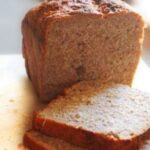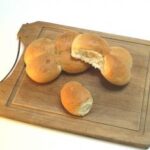There are not many things that smell better than a fresh baked loaf of bread. With a little bit of work, you can achieve that in your own home. While it is not difficult, it can be time consuming. I suggest you plan to attempt your first loaf of bread during a time when you will be at home for about four hours. Baking bread from scratch is a little like doing laundry. You work for a few minutes and then you are free to do something else while the machine works. The machine in this case is the yeast and the oven.
The materials you will need are a large bowl, any type, a wooden spoon, a one cup measuring cup for liquids and a loaf pan or other desired pan. You will need three cups of flour, any type that you prefer. I use two cups stone ground wheat flour and one cup white. It gives me the smooth texture my family prefers with the wholesomeness of wheat. I would like to try some of the white whole wheat flour I just read an article about in my local paper. The next ingredient is one teaspoon of salt. Yeast is mainly sold in packets or jars. If you are not sure about baking, I would suggest that you buy the packets to start. The jars are a better price per serving, so if you think you will be baking several loaves, purchase the jar. Depending on which kind of yeast that you use, you will need either one packet or two teaspoons. One tablespoon of sugar is needed for the yeast to feed. I really like unrefined natural sugar, but you can use whatever sweetener that you like. Those are all the dry ingredients. Use a wooden spoon or your hands to mix them all together in your large bowl.
In your measuring cup, measure one cup of warm tap water. It should be warm enough that the chill is gone, but not hot. If the water is too cold, the yeast will not be activated. If it is too hot, the yeast will be killed. Either way equals a bad loaf of bread. Add to the water two tablespoons of vegetable oil. I prefer canola oil, but whatever you have should work.
In your large bowl filled with dry ingredients, make a well in the middle of the dry ingredients. You can do this by pushing the flour mixture up against the sides of your bowl. Pour your liquid ingredients into the center of your mixing bowl. Using the wooden spoon you used earlier, mix all the ingredients together. The dough should begin to come together. Using your hands, form the dough into a ball. If you can’t incorporate all of the dry ingredients, that is okay. They will come together during the next step.
Lay the dough on a lightly floured surface. Pour any leftover dry ingredients on top of the ball of dough. At this point I like to fill my bowl with hot, soapy water. That will make it easier to clean when you need it in a few minutes. Use this opportunity to examine your hands. You will not want to be wearing any jewelry on your hands or wrists. Make sure that your hands are clean. Wash them if needed. Now you will begin the process called kneading. Kneading is defined as: to mix and work into a uniform mass, as by folding, pressing, and stretching with the hands. This is a very simple process and will help to incorporate all the leftover flour. You should press the dough with the heel of your hand and fold it over. Turn the dough and repeat. No action is wrong, do what feels comfortable. This is the most physical part of making bread. Keep kneading the dough for a full five minutes. Feel free to use a timer. This is a very important step. Make sure you knead for a full five minutes. This process is what makes the dough light and airy. You may add extra flour as you knead, if required. After time is up, form the dough into a ball and leave it to rest where you were working. Wash your hands and your bowl. After drying, put a small amount of oil into the center of the bowl. One or two teaspoons should be enough. Roll the formed ball of dough in the oil making sure to coat the entire ball of dough with a little oil. Cover with a clean tea towel.
This will begin the first rising of the dough. Leave the bowl covered on the counter until the dough has doubled in size. This could take an hour to an hour and a half. Be sure to let it rise enough. It will take longer if the house is very cool. After the dough has risen, punch the center of the dough. This releases any air that has become trapped in the dough. On a lightly floured surface, knead for a minute or two. This is just to make sure that any air pockets have been worked out. Form dough into the shape you want it to be when you bake it. I prefer to have the original loaf shape, but you can make any shape you like. If you would like a round loaf, you would not use a loaf pan. Anything you have available would work. Leave your dough to rest. While it is resting, you should generously grease your loaf pan or other desired pan. Put your dough into your pan and cover with the tea towel. Leave the pan covered on the counter for the second rising of the dough. It will double in size, again. This will probably take about another hour. It will take longer if your house is cooler. Make sure that you don’t rush the dough. Wait until it is at least double in size each time that you let the dough rise.
When the dough has risen, put the pan into a 350 degree oven. There is no need to preheat the oven. Bake for 30 minutes. After the time is up, you need to check to see if it is done. To do this, you need to pop it out of the pan and thump the loaf of bread. If it sounds hollow, it is done. If it does not, you need to put it back into the pan and bake a little while longer. I would check it quite frequently if I needed to put it back into the oven. Slice bread with a serrated bread knife. This is delicious used as you would any store bought bread.
I have baked this bread many times and it has turned out wonderful every time. I have never had to bake it longer than the 30 minutes, but some people might have to since different climates and ovens can affect your bread. Once you practice, you should be able to bake a loaf of bread in between running errands or shopping. After you are familiar with the process, you will not be stuck at home. Another benefit to homemade bread is that you can be sure of the quality of ingredients used to make it. You are the one who selects the ingredients, so you will know if the bread was made with organic flour, refined sugar or any other ingredients you want or don’t want. Give it a try, it is really not that hard.



